Penegra dosages: 100 mg, 50 mg
Penegra packs: 10 pills, 30 pills, 60 pills, 90 pills, 120 pills
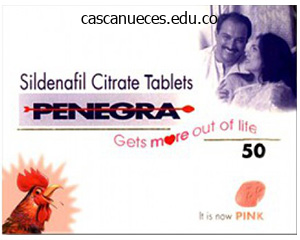
Order penegra 100mg with amex
The elderly are particularly at risk for pernicious anemia because the stomach mucosa (which produces intrinsic factor) atrophies with age. Dissolved in plasma (primarily water) are nutrients, gases, hormones, wastes, proteins, salts, and so on. Plasma composition changes as physique cells remove or add substances to it, however homeostatic mechanisms act to hold it comparatively constant. Formed components, the dwelling blood cells that make up about 45 % of entire blood, embrace the next: 354 Essentials of Human Anatomy and Physiology eight. All fashioned parts arise in pink bone marrow from a standard stem cell, the hemocytoblast. Stoppage of blood loss from an injured blood vessel, or hemostasis, entails three steps: vascular spasms, platelet plug formation, and blood clot formation. Vascular spasms and accumulation of platelets on the web site quickly stop or sluggish blood loss. An attached clot that forms or persists in an unbroken blood vessel is a thrombus; a clot touring in the bloodstream is an embolus. Abnormal bleeding might mirror a deficit of platelets (thrombocytopenia), genetic components (hemophilia), or inability of the liver to make clotting factors. Congenital blood defects embrace varied kinds of hemolytic anemias and hemophilia. Incompatibility between maternal and fetal blood can lead to fetal cyanosis, ensuing from destruction of fetal blood cells. If an Rh- mom becomes pregnant, when can hemolytic illness of the newborn not presumably occur within the child Lee, a man on a long-term drug therapy, reveals an abnormally excessive proportion of nonhematopoietic connective tissue. If the signs are critical, what short-term and long-term treatments are indicated A woman comes to the clinic complaining of fatigue, shortness of breath, and chills. A affected person is recognized with bone marrow cancer and has a hematocrit of 70 %. A middle-aged faculty professor from Boston is within the Swiss Alps learning astronomy. Upon returning to the United States, he has a complete physical examination and is told that his erythrocyte depend is higher than normal. Explain how fetal hemoglobin, HbF, enhances oxygen switch throughout the placenta from the mother to the fetus. Brittany, a wholesome young lady, had a battery of tests throughout a bodily for a new job. When asked if any circumstances had changed in her life, she admitted to taking up smoking. Malone is going into shock because of blood loss, so paramedics infuse a saline solution. Why is there a transfusion reaction the second time he or she receives the Rh+ blood If you had a high hematocrit, would you expect your hemoglobin determination to be excessive or low Blood vessels present the conduits inside which blood circulates to all body tissues. The Cardiovascular System When most people hear the term cardiovascular system, they immediately think of the center. We have all felt our personal coronary heart "pound" from time to time, and we tend to get a bit nervous when this happens. However, the cardiovascular system is rather more than simply the heart, and from a scientific and medical standpoint, it is necessary to understand why this method is so important to life. Night and day, minute after minute, our trillions of cells take up nutrients and excrete wastes. Although the pace of these exchanges slows throughout sleep, they must go on repeatedly, as a outcome of when they cease we die. Cells can make such exchanges only with the tissue fluid in their immediate neighborhood. Thus, some means of fixing and "refreshing" these fluids is necessary to renew the vitamins and stop air pollution attributable to the buildup of wastes.
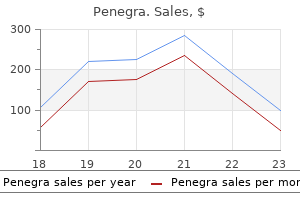
Order 100mg penegra otc
Blood flow is driven by these similar differences in stress, but with no filter present. The excessive strain in these arteries forces the blood to continuously move into areas the place the strain is decrease. Recall that the blood flows into the smaller arteries, then arterioles, capillaries, venules, veins, and eventually again to the massive venae cavae getting into the proper atrium of the guts. It flows repeatedly along a pressure gradient (from excessive to low pressure) as it makes its circuit day in and time out. Notice that if venous return depended totally on a hypertension all through the system, blood would probably by no means have the flexibility to full its circuit back to the guts due to the low stress in massive veins. This is why the valves within the bigger veins, the milking activity of the skeletal muscles, and stress modifications within the thorax are so important. The pressure variations between arteries and veins turn out to be very clear when these vessels are minimize. If a vein is reduce, the blood flows evenly from the wound; a lacerated artery produces rapid spurts of blood. Continuous blood flow absolutely depends on the stretchiness of the bigger arteries and their capability to recoil and hold exerting pressure on the blood because it flows off into the circulation. However, when the water faucet is all of a sudden turned off, the flow of water stops just as abruptly. Arteriosclerosis can also be called "hardening of the arteries" (see "A Closer Look" on pp. Thus, two arterial blood pressure measurements are usually made: systolic (sis-tolik) stress, the stress in the arteries on the peak of ventricular contraction, and diastolic (dius-tolik) stress, the stress when the ventricles are stress-free. Blood pressures are reported in millimeters of mercury (mm Hg), with the higher systolic stress written first-120/80 (120 over 80) translates to a systolic pressure of one hundred twenty mm Hg and a diastolic pressure of eighty mm Hg. Most typically, systemic arterial blood 11 384 Essentials of Human Anatomy and Physiology Blood pressure a hundred and twenty systolic 70 diastolic (to be measured) Pressure in cuff above one hundred twenty; no sounds audible a hundred and twenty mm Hg Rubber cuff inflated with air Pressure in cuff beneath 120, however above 70 Pressure in cuff under 70; no sounds audible 120 mm Hg 70 mm Hg 70 mm Hg Brachial artery (a) the course of the brachial artery of the arm. Brachial artery closed (b) the blood strain cuff is wrapped snugly across the arm just above the elbow and inflated until the cuff strain exceeds the systolic blood strain. Sounds audible in stethoscope (c) the strain within the cuff is steadily lowered while the examiner listens (auscultates) for sounds in the brachial artery with a stethoscope. The pressure read as the primary delicate tapping sounds are heard (the first level at which a small amount of blood is spurting through the constricted artery) is recorded because the systolic pressure. Peripheral resistance is the amount of friction the blood encounters because it flows through the blood vessels. Many factors increase peripheral resistance, however probably an important is the constriction, or narrowing, of blood vessels, especially arterioles, as a outcome of both sympathetic nervous system exercise or atherosclerosis. Increased blood quantity or increased blood viscosity (thickness) also raises peripheral resistance. Any factor that will increase either cardiac output or peripheral resistance causes an virtually quick reflex rise in blood strain. Many elements can alter blood pressure-age, weight, time of day, train, body place, emotional state, and numerous medication, to name a number of. The parasympathetic division of the autonomic nervous system has little or no effect on blood stress, however the sympathetic division is important. For example, after we stand up all of a sudden after mendacity down, the effect of gravity causes blood to pool in the vessels of the legs and toes, and blood stress drops. This activates pressoreceptors, additionally called baroreceptors (baro = pressure), in the large arteries of the neck and chest. They ship off warning alerts that result in reflexive vasoconstriction, growing blood stress back to homeostatic ranges. When blood quantity abruptly decreases, as in hemorrhage, blood strain drops, and the guts begins to beat more rapidly because it tries to compensate. However, because blood loss reduces venous return, the center additionally beats weakly and inefficiently. In such instances, the sympathetic nervous system causes vasoconstriction to increase the blood pressure so that (hopefully) venous return will increase and circulation can proceed. The final instance considerations sympathetic nervous system activity after we exercise vigorously or are frightened and should make a hasty escape. The vessels of the skeletal muscular tissues dilate to increase the blood circulate to the working muscular tissues. The kidneys play a significant function in regulating arterial blood stress by altering blood volume.
Diseases
- Spastic paraplegia type 2, X-linked
- Thumb absence hypoplastic halluces
- Goldblatt Wallis syndrome
- Synovitis
- Warman Mulliken Hayward syndrome
- Infantile onset spinocerebellar ataxia
- Spastic paraplegia neuropathy poikiloderma
- Lower mesodermal defects
- Geliphobia
Purchase 100 mg penegra overnight delivery
A noncontrast sequence is adopted by intravenous contrast-enhanced sequence in arterial and delayed phases. This could be prohibitive in patients with poor renal function, particularly when considering the extra distinction required in a subsequent endovascular procedure. Technetium 99m (Tc-99m)�labeled purple blood cell scans can detect bleeding charges as low as zero. In sufferers with hemodynamic instability, research with an instantaneous tracer blush usually tend to have a constructive angiogram than studies with a delayed blush. Once active hemorrhage is documented and localized with a diagnostic radiology study, patients ought to be transferred instantly to the angiography suite. Angiography Indications the first indication for standard angiography is the lack to management the source of bleeding endoscopically. Angiography is favored over surgical procedure because the treatment of choice after failed endoscopic therapy, significantly in high-risk surgical patients. Endovascular embolization is also the first treatment for hepatobiliary bleeding. Embolization is much less likely to succeed in the setting of coagulopathy as a end result of the most typical embolic agent used-coils-causes vessel obstruction by providing a scaffold for thrombus formation rather than by pure mechanical occlusion. Even in the setting of uncorrectable coagulopathy, embolization typically stays the most suitable choice for remedy. In these scenarios, alternative embolic agents together with placement of a Gelfoam sandwich or the applying of glue or Onyx (Micro Therapeutics Inc. One must also think about the angle at which the mesenteric vessels arise from the aorta. The right widespread femoral artery is the default access web site for mesenteric angiography. This is helpful in identifying the ostia of the mesenteric vessels and in guiding subsequent catheter choice. This step takes only a few minutes to accomplish and may save useful time afterward in the procedure. Power injection is performed at a fee of 20 mL per second, for a total volume of 30 mL. It is essential to seat the catheter simply past the ostium of the mesenteric vessel. Power injection of contrast is used for all angiograms to optimize detection of energetic bleeding. A microcatheter is preferred in these circumstances to keep away from inducing vasospasm earlier than the culprit vessel is identified. The primary angiographic findings of bleeding are visualization of energetic contrast extravasation and contrast pooling within the venous phase. Other oblique signs of bleeding on angiography embody pseudoaneurysm, vessel spasm or cutoff, early venous filling, and hypervascularity Table 29. This can characterize a bleeding source if such an entity was suspected on prior endoscopy. Not uncommonly, trial subselection of vessels is necessary to demonstrate bleeding. It additionally has poorer spatial resolution, which can impair subsequent endovascular remedy. Several methods have been reported, together with the administration of anticoagulants, vasodilators, and fibrinolytics, to temporarily augment bleeding and enhance diagnostic sensitivity. If no arterial abnormality is seen, empiric embolization of the vessels supplying the world of concern may be carried out. The left gastric artery, which runs along the lesser curve of the abdomen, provides the distal esophagus, cardia, fundus, and incisura. There is collateralization with branches of the brief gastric and proper gastric arteries, which generally come up from the splenic and hepatic arteries respectively. There has been shown to be no statistical difference in outcomes between patients treated with empiric embolization versus embolization after angiographically demonstrated contrast extravasation. Although the number of arteries embolized may not impression medical success of embolotherapy,25 it could affect subsequent surgical therapy. This usually requires coaxial placement of a 3-Fr microcatheter through a 5-Fr catheter. At our institution, we commonly employ a Renegade (Boston Scientific Corporation, Natick, Massachusetts) or a Progreat (Terumo, Tokyo, Japan) microcatheter.

Discount penegra master card
Last, the "balloon stent" methodology entails a stent placement after completion of a balloon-assisted embolization. A drawback is that it requires everlasting placement of the system and a minimal antiplatelet routine of no less than three months. Most aneurysms treated with stent-assisted coiling are geometrically complex and pose a technical challenge. Stent Reconstruction Despite all these system developments and the refinement of technical nuances by skilled operators, broad-necked aneurysms arising at bifurcations that incorporate the daughter vessel origins remain a formidable challenge to endovascular therapy. This is probably finest exemplified by the problem in treating middle cerebral artery bifurcation aneurysms but additionally those at the basilar apex and carotid terminus. At vascular bifurcations, a stent can be utilized to stabilize a coil mass inside an aneurysm whereas protecting the parent vessel and the daughter vessel at biggest threat. The "Y-stent" technique35�40 includes the passage of a second stent by way of the interstices of the first deployed stent. Y-stent reconstruction enables the endovascular management of otherwise advanced, wide-necked cerebral aneurysms by offering two critical functions: assist for the coil mass and preservation of the daughter vessels. The open-cell design of the Neuroform stent because the preliminary positioned stent permits this assemble to be attainable as a result of the primary stent deployed can broaden at its interstices to accommodate the second self-expanding stent. Y-stent utilizing a closed-cell design stent on the first stent, though technically feasible, leads to undesirable synching of the second deployed stent due to its constrained interstices. The initial shortand midterm results utilizing the Y-configuration approach are promising. These results have been thought-about passable as a result of the technique addresses aneurysms for which there are in any other case no viable treatment options. However, there are a number of issues relating to the longterm effects in patients harboring the Y-configured reconstruction. Initial microcatheter choice and reaccessing of the aneurysm throughout coiling following Y stenting can even pose a problem. Indeed, there are numerous steps required to successfully obtain Y-stent reconstruction, each with risk of technical complications. Stent Delivery by way of Balloon Catheter Balloon-remodeling and stent help methods could additionally be utilized in combination to capitalize on the advantages that every affords. This "balloon� stent" technique involves stent placement after completion of a balloon-assisted embolization. The disadvantage to this sequential method is that using presently available stent delivery systems requires both a zero. In addition, this step might add fluoroscopy and procedure time, especially when access to the lesion is difficult. We described the primary report of a novel technique for "balloon stenting," which incorporates the usage of two novel gadgets. It is a compliant, closed-cell system which is retrievable up to 80% deployment and provides 15% surface area coverage. We have found this method to be safe and possible, lowering both the variety of steps involved on this technique and the opportunities for mechanical coil-related issues. Flow Diversion Stents had been recognized to impart move diversion properties on aneurysm influx, spurring the introduction of move diversion stents. Flow-diverting stents are constructed of decrease porosity with larger device surface space protection on the aneurysm neck. Theoretically, even small-caliber perforating vessels, which are lined by the flow diverter, will stay patent due to the siphoning impact of the distal territory they irrigate. Flow diversion has been used effectively within the treatment of fusiform and large aneurysms. Disadvantages include the inability to cross the stent with a microcatheter for treatment of recurrences, stories of perforator occlusions resulting in strokes, in addition to reported cases of delayed aneurysmal rupture and subacute and distant intracerebral hemorrhage. Pushing the Envelope Despite these technologic advances, broad-based aneurysms proceed to pose a formidable problem for endovascular remedy, which requires artistic solutions. Retrievable, closed-cell design stents may be partially deployed across an aneurysm neck and then recaptured following stent-assisted coil embolization, thereby incorporating the benefits of balloon transforming with out the drawbacks of parent vessel occlusion and with out permanent stent implantation. A stent may also be deployed with its distal extent aimed at the aperture of the aneurysm to help a coil mass rather than throughout the neck along the lengthy axis of the father or mother vessel, the so-called waffle cone approach. Last, to promote thrombosis and occlusion of fusiform aneurysms, some operators advocate jailing a microcatheter with a flow-diverting stent to seize the benefits of circulate diversion and coil embolization in one technique.
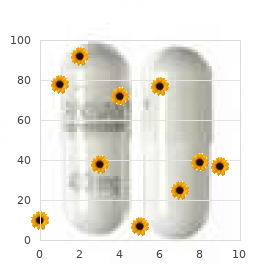
Purchase penegra visa
Assessment of the human splanchnic venous volume-pressure relation using radionuclide plethysmography. Volume-pressure relations of the human pulmonary "venous" system studied by radionuclide angiocardiography and passive leg elevation, with special reference to the impact of nitroglycerin. Acute changes in forearm venous quantity and tone utilizing radionuclide plethysmography. A methodology for the estimation of hydration state throughout hemodialysis using a calf bioimpedance technique. Percentage of total physique fats as estimated by three automatic bioelectrical impedance analyzers. The movement of fluid via the human capillary wall in relation to venous stress and to the colloid osmotic stress of the blood. The impact of posture (standing) on the serum protein concentration and colloid osmotic pressure of blood from the foot in relation to the formation of edema. The results of position and pores and skin temperature on the capillary pressures within the fingers and toes. Intrathoracic and venous pressure relationships throughout responses to adjustments in body position. Nocturnal rostral fluid shift: a unifying idea for the pathogenesis of obstructive and central sleep apnea in males with coronary heart failure. Role of nocturnal rostral fluid shift in the pathogenesis of obstructive and central sleep apnoea. Sleep-disordered breathing and cardiovascular disease: cross-sectional outcomes of the Sleep Heart Health Study. Sleep-disordered respiratory occurs regularly in steady outpatients with congestive heart failure. Sleep problems in systolic heart failure: a potential research of a hundred male patients. A high prevalence of sleep disordered inhaling men with mild symptomatic persistent heart failure due to left ventricular systolic dysfunction. Sleep disordered breathing in coronary heart failure sufferers with decreased versus preserved ejection fraction. Sleep-disordered inhaling coronary heart failure with normal left ventricular ejection fraction. High prevalence of sleep apnea in heart failure outpatients: even in sufferers with preserved systolic perform. Sleepiness and sleep in patients with both systolic coronary heart failure and obstructive sleep apnea. Symptoms of sleep apnoea in persistent coronary heart failure � results from a potential cohort study in 1,500 sufferers. Relationship of coronary heart rate variability to sleepiness in sufferers with obstructive sleep apnea with and with out coronary heart failure. Inverse relationship of subjective daytime sleepiness to sympathetic activity in sufferers with coronary heart failure and obstructive sleep apnea. Inhibition of awake sympathetic nerve activity of coronary heart failure patients with obstructive sleep apnea by nocturnal steady constructive airway strain. Prognostic impact of sleep disordered breathing and its therapy in heart failure: an observational study. Pharyngeal size in snorers, nonsnorers, and sufferers with obstructive sleep apnea. Pharyngeal compliance in loud night breathing subjects with and without obstructive sleep apnea. Contributions of higher airway mechanics and management mechanisms to severity of obstructive apnea. Pharyngeal form and dimensions in wholesome subjects, snorers, and patients with obstructive sleep apnoea.
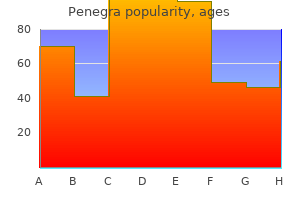
50mg penegra with mastercard
Furthermore, patients with insufficient sphincter of Oddi are at increased risk of hepatic abscess formation, and in these cases, preprocedural and postprocedural biliary excreted antibiotic protection is obligatory. The advantage of this route is proportional to the first-pass extraction of the drug by the liver and inversely proportional to body clearance. This allows intermittent administration with repeated course of chemotherapy over few weeks by way of the peripheral arterial entry the place a everlasting subcutaneous port is linked to the intra-arterial catheter. This is done to stop any extrahepatic delivery of the chemotherapeutic agent in the gastrointestinal tract. First, any arterial branches that may cause supply of the chemotherapy outdoors the liver must be occluded with coil percutaneously. In the event of extrahepatic accumulation of tracer, angiographic embolization should be wanted to correct the circulate and salvage the intra-arterial pump/catheter for secure chemotherapy administration. Forty-eight % of sufferers have been downstaged sufficient to undergo an R0 resection and/or ablation. Such embolization has been reported to induce failure of the transmembrane pump, thus rising drug retention inside cells. The factors predictive of antagonistic occasions and considerably larger hospital length of stay are lack of pretreatment with hepatic arterial lidocaine (P =. Radioembolization delivers focused radiation remedy to unresectable liver metastases by the injection of -emitting isotope Y90, which is certain to nondegradable microspheres into the arterial supply of the liver. These microspheres are unable to move by way of the vasculature of the liver because of their relatively large dimension compared to the capillaries and are therefore trapped within the tumor capillaries. The physical properties of this radioactive isotope are a half-life of sixty four hours and no -energy emission, thus allowing immediate launch of the patient after remedy. This allows delivery of high dose of ionizing radiation to the tumor with minimal radiation to surrounding tissue and thus causing significantly less toxicity to the traditional liver. The lung shunting fraction is defined because the percent shunt fraction of microspheres from liver to lung. The dose of radioactive microspheres must be tailored according to the lung shunting fraction. At the identical time, this selective method eliminates the necessity of prophylactic embolization of vessels that may not be a supply of extrahepatic supply of radioactive spheres because of reflux. For sufferers with bilobar disease, the lobe with essentially the most lesions must be treated first, and administration to the contralateral lobe must be carried out in a separate session 4 to 6 weeks later. New developments now permit the secure supply of Y90 spheres with out the necessity for coil embolization. This permits instant visualization and really early detection of reflux that further increases the safety of Y90 administration. Finally, using antireflux catheters also permits the delivery of the entire dose without the necessity of coil embolization. Overall response of 17% to 35% and stable disease charges of 24% to 61% have been described. Modest results of radioembolization have been seen when it was used as a salvage monotherapy after full chemotherapy failure. Radioembolization alone in this setting confirmed an general response of 24%, a progression-free survival of 3. Tumor management and reduce in tumor load in metastatic illness is achieved with systemic therapy. In addition, if the drug injected within the hepatic artery is selectively retained within the liver during embolization, systemic passage and due to this fact systemic toxicity of the drug shall be lowered as well. Several series have shown the safety and efficacy of this therapy even in the most heavily and compromised sufferers with colon cancer hepatic metastases. The number of one of the best therapy for each affected person certainly requires multidisciplinary discussion and cooperation. It carries a risk, nonetheless, for radiation-induced liver disease that has been reported as late as four months after remedy. Therefore, if local development is documented at quick time interval after one arterially directed therapy, one would possibly contemplate the utilization of a unique arterially directed treatment.
Millefolii herba (Yarrow). Penegra.
- Are there safety concerns?
- Dosing considerations for Yarrow.
- What is Yarrow?
- Fever, common cold, hayfever, diarrhea, stomach discomfort, bloating, gas, toothache, and other conditions.
- How does Yarrow work?
- Are there any interactions with medications?
Source: http://www.rxlist.com/script/main/art.asp?articlekey=96188
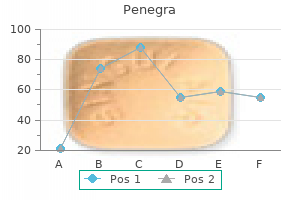
Purchase penegra online
This is (somewhat) dangerous as a outcome of both hydrochloric acid and the protein-digesting enzymes have the flexibility to digest the abdomen itself, inflicting ulcers (see "A Closer Look" on p. However, as long as enough mucus is made, the stomach is "secure" and can stay unhurt. This leads to a attribute ache known as heartburn, which, if uncorrected, leads to inflammation of the esophagus (esophagitis [e-sofah-jitis]) and perhaps even to ulceration of the esophagus. A widespread trigger is a hiatal hernia, a structural abnormality in which the superior a half of the Chapter 14: the Digestive System and Body Metabolism Bolus of meals 481 Tongue Pharynx Epiglottis up Glottis (lumen) of larynx Trachea (a) Upper esophageal sphincter contracted Uvula Bolus Upper esophageal sphincter Larynx up Esophagus (b) Upper esophageal sphincter relaxed Epiglottis down Bolus (c) Upper esophageal sphincter contracted Relaxed muscular tissues Cardioesophageal sphincter open the meals bolus posteriorly and against the soft palate. The larynx rises so that the epiglottis covers its opening as peristalsis carries the food via the pharynx and into the esophagus. Because the diaphragm no longer reinforces the cardioesophageal sphincter, which is a weak sphincter to start with, gastric juice flows into the unprotected esophagus. Conservative therapy involves restricting food consumption after the night meal, taking antacids, and sleeping with the head elevated. The extremely acidic surroundings that hydrochloric acid provides is critical, as a outcome of it prompts pepsinogen to pepsin, the active protein-digesting enzyme. Rennin, the second protein-digesting enzyme produced by the stomach, works totally on milk protein and converts it to a substance that looks like bitter milk. Many mothers mistakenly suppose that the curdy substance infants usually spit up after feeding is milk that has soured of their abdomen. Other than the beginning of protein digestion, little chemical digestion happens in the abdomen. Except for aspirin and alcohol (which seem by some means to have a "particular pass"), just about no absorption occurs by way of the abdomen walls. As meals enters and fills the abdomen, its wall begins to stretch (at the identical time the gastric juices are being secreted, as simply described). They compress and pummel the food, breaking it apart bodily, all the while continuously mixing the meals with the enzyme-containing gastric juice in order that the semifluid chyme is formed. The pyloric finish of the abdomen acts as a pump that delivers small quantities of chyme into the duodenum. The process appears one thing like the preparation of a cake mix, by which the floury combination is repeatedly folded on itself and combined with the liquid till it reaches uniform texture. The pylorus of the abdomen, which holds 2 about 30 ml of chyme, acts like a meter that al3 lows only liquids and really small particles to cross three through the pyloric sphincter. Because the pyloric four four sphincter barely opens, every contraction of the 5 abdomen muscle squirts 3 ml or much less of chyme into 5 1 the small intestine. When the duodenum is full of chyme and four its wall is stretched, a nervous reflex, the enterogastric (enter-o-gastrik) reflex, occurs. It slows the emptying of the stomach by inhibiting the vagus nerves and tightening the pyloric sphincter, thus permitting time for intestinal processing to catch up. Generally, it takes about four hours for the abdomen to empty fully after the particular person eats a wellbalanced meal and 6 hours or more if the meal has a excessive fat content material. Vomiting is essentially a reverse peristalsis occurring in the abdomen (and perhaps the small intestine), accompanied by contraction of the abdominal muscles and the diaphragm, which will increase the strain on the stomach organs. The emetic heart may be activated via other pathways; disturbance of the equilibrium apparatus of the inner ear throughout a ship journey on tough water is one example. Carbohydrate and protein digestion has begun, but just about no fats have been digested up to this level. Here the method of chemical meals digestion is accelerated because the meals now takes a rather wild 3- to 6-hour journey by way of the looping coils and twists of the small gut. By the time the food reaches the tip of the small gut, digestion is full and almost all meals absorption has occurred. Intestinal juice itself is comparatively enzyme poor, and protecting mucus is probably crucial intestinal gland secretion. However, foods entering the small gut are actually deluged with enzyme-rich pancreatic juice ducted in from the pancreas, as nicely as bile from the liver. Pancreatic juice contains enzymes that (1) along with brush border enzymes, complete the digestion of starch (pancreatic amylase); (2) perform about half of protein digestion (via the action of trypsin, chymotrypsin, carboxypeptidase, and others); (3) are totally responsible for fats digestion, as a result of the pancreas is basically the one source of lipases; and (4) digest nucleic acids (nucleases).
Order penegra online pills
The axon of this ganglionic neuron, the postganglionic axon, then extends to the organ it serves. The sympathetic division mobilizes the physique throughout excessive conditions (such as worry, exercise, or rage), whereas the parasympathetic division allows us to "unwind" and preserve vitality. For this purpose, the parasympathetic division is also known as the craniosacral division. The neurons of the cranial area ship their axons out in cranial nerves to serve the top and neck organs. From the terminal ganglion, the postganglionic axon extends a short distance to the organ it serves. In the sacral area, the preganglionic axons go away the spinal twine and type the pelvic splanchnic (splanknik) nerves, also called the pelvic nerves, which journey to the pelvic cavity. In the pelvic cavity, the preganglionic axons synapse with the second motor neurons in terminal ganglia on, or close to, the organs they serve. The sympathetic trunk, or chain, lies alongside the vertebral column on each side. The splanchnic nerves journey to the viscera to synapse with the ganglionic neuron, found in a collateral ganglion anterior to the vertebral column. The main collateral ganglia-the celiac and the superior and inferior mesenteric ganglia-supply the belly and pelvic organs. The postganglionic axon then leaves the collateral ganglion and travels to serve a nearby visceral organ. Autonomic Functioning 7-23 Contrast the effect of the parasympathetic and sympathetic divisions on the following organs: heart, lungs, digestive system, blood vessels. Body organs served by the autonomic nervous system receive fibers from each divisions. Exceptions are most blood vessels and most constructions of the pores and skin, some glands, and the adrenal medulla, all of which receive solely sympathetic fibers Table 7. The parasympathetic fibers, referred to as cholinergic (kolin-erjik) fibers, launch acetylcholine. The sympathetic postganglionic fibers, referred to as adrenergic (adren-erjik) fibers, launch norepinephrine (norep-i -nefrin). Its exercise is obvious when we are excited or discover ourselves in emergency or threatening conditions, similar to being frightened by road toughs late at night. A pounding coronary heart; rapid, deep respiration; cold, sweaty pores and skin; a prickly scalp; and dilated eye pupils are positive indicators of sympathetic nervous system activity. Under such situations, the sympathetic nervous system will increase heart rate, blood strain, and blood glucose levels; dilates the bronchioles of the lungs; and brings about many other results that assist the person address the stressor. Other examples are dilation of blood vessels in skeletal muscle tissue (so that we will run quicker or battle better) and withdrawal of blood from the digestive organs (so that the majority of the blood can be utilized to serve the guts, brain, and skeletal muscles). The effects of sympathetic nervous system activation continue for several minutes until its hormones are destroyed by the liver. Thus, although sympathetic nerve impulses themselves could act only briefly, the hormonal effects they provoke linger. The sympathetic division generates a head of steam that enables the physique to cope quickly and vigorously with conditions that threaten homeostasis. Its operate is to present the best circumstances for responding to some threat, whether the most effective response is to run, to see higher, or to suppose more clearly. Certain individuals, known as type A individuals, always work at breakneck speed and push themselves regularly. These are people who are prone to have heart disease, high blood pressure, and ulcers, all of which may be worsened by prolonged sympathetic nervous system activity or the rebound from it. Parasympathetic Division the parasympathetic division is most energetic when the physique is at rest and never threatened in any method. This division, generally referred to as the "resting-and-digesting" system, is chiefly involved with promoting regular digestion, with elimination of feces and urine, and with conserving body power, notably by decreasing 268 Essentials of Human Anatomy and Physiology Table 7. Its activity is best illustrated by an individual who relaxes after a meal and reads the newspaper. The eye pupils are constricted to shield the retinas from excessive damaging mild, and the lenses of the eyes are "set" for shut imaginative and prescient. We may additionally think about the parasympathetic division because the "housekeeping" system of the body.
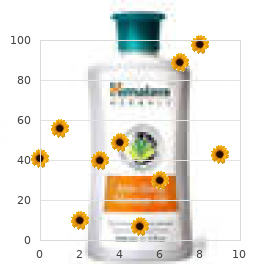
Order penegra with amex
This is a crucial principle to keep in mind when deciding on an embolic agent Table 29. Coils Coils are probably the most generally used embolic agent as properly as the agent of selection at our institution. They are, however, permanent and may forestall reaccessing the goal vessel should bleeding recur. Coils are available in a massive selection of sizes, permitting one to accurately match the focused vessel diameter. These larger diameter coils expedite vessel occlusion by their inherent dimension, and the extra steps involved in positioning the microcatheter are averted. Coil placement could be alternated with infusion of a slurry of gelatin sponge (Gelfoam; Pfizer, New York, New York) to create a "Gelfoam sandwich. These enable the operator to retract and reposition coils or even utterly retrieve the coil earlier than final placement. If inappropriately positioned, coils can preclude subsequent endovascular entry to the targeted lesion or vessel. In such situations, surgical intervention could be the only remaining therapy possibility ought to bleeding recur. Gelatin Sponge Use of Gelfoam alone provides a variable degree of short-term hemostasis as embolized vessels will recanalize over 2 to 6 weeks. This inhabitants has altered vascular anatomy and collateral circulation may be diminished or absent. In such circumstances, coil embolization could also be relegated to the second option after Gelfoam pledgets due to the heightened concern for bowel ischemia. Keep in thoughts, however, that bowel necrosis can happen inside eight to 12 hours in the setting of acute mesenteric ischemia. Thus, any decision to perform embolization in patients with surgically altered anatomy must be made after consultation with surgical colleagues. As previously noted, gelatin sponge is used most commonly as a element of a Gelfoam sandwich along side coils. Gelfoam may also be helpful when embolizing hepatic arteries within the setting of compromised portal vein patency. In these circumstances, Gelfoam could additionally be a better option to handle acute hemorrhage whereas allowing for future blood flow to hepatocytes and bile ducts after recanalization of the vessel. A 1-mL syringe of saline may be helpful to clear catheter occlusions when administering Gelfoam. Note that nontarget embolization is a potential unfavorable repercussion to utilizing Gelfoam in this method. Particles Neoplasm-induced hemorrhage is the lone setting by which the usage of particles is mostly agreed to be protected and presumably advantageous. The authors suggest utilizing particles no smaller than 500 �m to keep away from the risk of bowel ischemia from nontarget embolization. Because of their small size and potential to reach the level of the intramural vasculature, particulate brokers, such as polyvinyl chloride or trisacryl gelatin microspheres, are theoretically related to an elevated danger of bowel infarction and organ necrosis. They work by polymerizing upon exposure to an ionic setting (blood) and immediately forming a cast of the vessel, causing everlasting occlusion. Their potential use is affirmed when contemplating that coagulopathy is related to a 2. Embolization of all collateral vessels is critical in these instances to prevent continued bleeding by way of retrograde pathways. The microcatheter should be positioned as close as attainable to the site of bleeding. Once injection is complete, the microcatheter should be removed instantly to prevent adherence to the catheter wall. However, all cases showed improvement on follow-up endoscopy and none required surgical intervention. Interestingly, the identical study also reported hepatic abscesses in 2 of 2 patients who underwent hepatic artery embolization.
Discount generic penegra uk
Immediate control of a large bleeding price ranges from 80% to 100% utilizing totally different embolic agents. The Achilles heel of this procedure is a recurrence up to 50% and even 75%, as acknowledged by some authors. If we consider small bloody sputum episodes without clinical significance, our recurrence shall be high. Some authors solely report episodes of hemoptysis requiring medical management (surgery or embolization). Late rebleeding (months or years), then again, is as a outcome of of development or reactivation of the underlying disease and lesion revascularization by collateral vessels from other bronchial arteries and systemic arteries of the neighborhood. Other causes embrace the usage of absorbable embolic brokers, acute vascular pathologic processes, or persistent diseases corresponding to tuberculosis, aspergillosis, and most cancers. Chronic or resistant tuberculosis has high fee of recurrence, whereas acute tuberculosis sensitive to antituberculosis remedy has a positive outcome with low rate of rebleeding after embolization. It is necessary to medically or surgically resolve the underlying condition, when potential. The underlying pathology should be treated if attainable to obtain long-term hemoptysis control. They are temporary signs because of ischemic phenomena attributable to embolization of intercostal and esophageal branches respectively. Every injection should be carried out underneath fluoroscopic control with a gradual, careful, and precise infusion of the mixture (iodine contrast and embolic agent, selecting an sufficient proportion relying on the contrast focus and the employed agent). Subintimal dissection of the aorta or the bronchial artery during hemoptysis embolization is another frequent minor complication, with a reported prevalence of 1% to 6. Probably the most feared and critical complication is the embolization of the anterior spinal artery, which can be caused by transverse myelitis. The prevalence of spinal cord ischemia after hemoptysis embolization is reported to be 1. Therefore, good imaging and intensive previous diagnostic angiographies or scans are important. Therefore, embolization should at all times be performed meticulously, slowly, and underneath fluoroscopic guidance to cease on time and avoid its unintentional embolization. Tricks � Do not introduce the diagnostic catheter (4-Fr to 5-Fr) into the bronchial artery to keep away from vasospasm. Embolization with nonabsorbable particles is the popular therapy of huge hemoptysis. Embolization is, normally, a symptomatic remedy: always remember the therapy of the underlying illness, if possible. Hemoptysis workup earlier than embolization: single-center experience with a 15-year period follow-up. Vascular intervention in the thorax: bronchial artery embolization for haemoptysis. Treatment, by embolization, of severe or repeated hemoptysis related to systemic hypervascularization [in French]. Bronchial artery embolization within the administration of hemoptysis: technical elements and long-term outcomes. Nonbronchial systemic collateral arteries: significance in percutaneous embolotherapy for hemoptysis. Massive hemoptysis as a end result of pulmonary tuberculosis: control with bronchial artery embolization. Immediate and long-term outcomes of bronchial artery embolization for life-threatening hemoptysis. Bronchial artery embolization for hemoptysis because of benign ailments: instant and long-term results. Bronchial and nonbronchial systemic artery embolization for life-threatening hemoptysis: a comprehensive review. Cryptogenic hemoptisis: medical options, bronchoscopic findings, and natural history in sixty seven patients.
References
- Fader AN, Rose EG. Role of surgery in ovarian carcinoma. J Clin Oncol. 2007;25:2873-83.
- Bell WH. Le Fort I osteotomy for correction of maxillary deformities. J Oral Surg 1975; 33:412-26.
- Iwata S, Jin Z, Schwartz JE, et al. Relationship between ambulatory blood pressure and aortic arch atherosclerosis. Atherosclerosis 2012;221(2):427-31.
- Savinainen KJ, Linja MJ, Saramaki OR, et al: Expression and copy number analysis of TRPS1, EIF3S3 and MYC genes in breast and prostate cancer, Br J Cancer 90:1041n1046, 2004.
- Slim K, Bousquet J, et al: Effect of CO(2) gas warming on pain after laparoscopic surgery: a randomized double-blind controlled trial, Surg Endosc 13(11):1110-1114, 1999.






